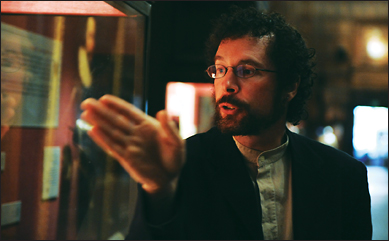Shakespearean Styles
Folger Exhibit Captures Trends in Armor, Weapons

With their exquisite craftsmanship and intricate tailoring, several of the suits and accessories on display in a new exhibit at the Folger Shakespeare Library encapsulate 16th- and 17th-century high fashion.
But the suits, gloves and various other pieces are not your typical wardrobe staples these high society must-haves are actually steel-plated armor.
You didnt want to be caught dead on the battlefield in last years armor, explained Jeffrey Forgeng, the curator of exhibit.
Now Thrive the Armorers: Arms and Armor in Shakespeare showcases more than 40 pieces of arms and armor from the Higgins Armory Museum in Worcester, Mass., and 34 books, manuscripts and works of art from the Folger collection.
The exhibit is more than just a nod to the top trends of William Shakespeares times. Beginning with Richard II, it traces how the changing role of armor and weaponry in society was depicted in eight of the bards plays.
The exhibit highlights the underlying symbolism of the weapons Shakespeares characters wield, said Forgeng, who is also the curator at the Higgins museum. For example, while the swords used to stage Tybalt and Benvolios duel in Romeo and Juliet might seem to the untrained eye to be simple props, the Italian-made rapiers can actually be interpreted as a nod to growing public concern that these foreign weapons were the culprit behind a rise in violence. The exhibit also shows the extent to which plays such as Othello and Hamlet capture fundamental shifts in the nature of military tactics and thinking during the era.
From an ornate gauntlet donned by Prince (later King) Philip II of Spain to a manuscript tracing the pedigrees of English families, many of the pieces on display are emblematic of personal identity and the feudal chivalric culture, Forgeng said. Even as the military became more professional and knights command on the battlefield diminished, the tradition of knighthood played a leading role in 16th- and 17th-century society.
[IMGCAP(1)]The concept of being a knight is really a unifying idea for the entire aristocracy, Forgeng said. These guys were the athletes of their day. They really were the superstars.
This is the first time the Folger has displayed armor in its public exhibition space, which typically hosts pieces from the librarys private collection.
Folger Librarian Richard Kuhta said though many think of armor as a relic of the medieval age and out of scope of the Folgers focus on Renaissance culture and literature, the collaboration with the Higgins has allowed even the most versed scholars to see the plays in a new light.
Its like a new set of eyes looking at the plays and looking at the language of arms and armor what they convey and what they mean, Kuhta said.





